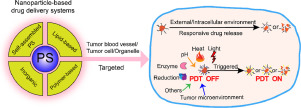当前位置:
X-MOL 学术
›
Eur. J. Pharm. Sci.
›
论文详情
Our official English website, www.x-mol.net, welcomes your
feedback! (Note: you will need to create a separate account there.)
Nanoparticle-based drug delivery systems for controllable photodynamic cancer therapy.
European Journal of Pharmaceutical Sciences ( IF 4.3 ) Pub Date : 2020-01-09 , DOI: 10.1016/j.ejps.2020.105213 Yilin Zheng 1 , Ziying Li 1 , Haijun Chen 2 , Yu Gao 1
European Journal of Pharmaceutical Sciences ( IF 4.3 ) Pub Date : 2020-01-09 , DOI: 10.1016/j.ejps.2020.105213 Yilin Zheng 1 , Ziying Li 1 , Haijun Chen 2 , Yu Gao 1
Affiliation

|
Compared with the traditional treatment, photodynamic therapy (PDT) in the treatment of malignant tumors has the advantages of less damage to normal tissues, quick therapeutic effect, and ability to repeat treatments to the same site. However, most of the traditional photosensitizers (PSs) have severe skin photosensitization, poor tumor targeting, and low therapeutic effect in hypoxic tumor environment, which limit the application of PDT. Nanoparticle-based drug delivery systems can improve the targeting of PSs and release drugs with controllable photoactivity at predetermined locations, so as to achieve desired therapeutic effects with minimal side-effects. The present review summarizes the current nanoparticle platforms for PDT, and offers the description of different strategies including tumor-targeted delivery, controlled-release of PSs and the triggered photoactivity to achieve controllable PDT by nanoparticle-based drug delivery systems. The challenges and prospects for further development of intelligent PSs for PDT are also discussed.
中文翻译:

基于纳米粒子的药物输送系统,用于可控的光动力癌症治疗。
与传统疗法相比,光动力疗法(PDT)治疗恶性肿瘤的优点是对正常组织的损伤小,治疗效果快,能够重复治疗同一部位。然而,大多数传统的光敏剂(PSs)具有严重的皮肤光敏性,不良的肿瘤靶向性以及在低氧肿瘤环境中的低治疗效果,这限制了PDT的应用。基于纳米颗粒的药物递送系统可以改善PS的靶向性,并在预定位置释放具有可控光活性的药物,从而以最小的副作用实现所需的治疗效果。本综述总结了当前用于PDT的纳米颗粒平台,并提供了不同策略的描述,包括肿瘤靶向递送,通过基于纳米颗粒的药物递送系统控制PS的释放和触发的光活性,以实现可控的PDT。还讨论了进一步开发用于PDT的智能PS的挑战和前景。
更新日期:2020-01-10
中文翻译:

基于纳米粒子的药物输送系统,用于可控的光动力癌症治疗。
与传统疗法相比,光动力疗法(PDT)治疗恶性肿瘤的优点是对正常组织的损伤小,治疗效果快,能够重复治疗同一部位。然而,大多数传统的光敏剂(PSs)具有严重的皮肤光敏性,不良的肿瘤靶向性以及在低氧肿瘤环境中的低治疗效果,这限制了PDT的应用。基于纳米颗粒的药物递送系统可以改善PS的靶向性,并在预定位置释放具有可控光活性的药物,从而以最小的副作用实现所需的治疗效果。本综述总结了当前用于PDT的纳米颗粒平台,并提供了不同策略的描述,包括肿瘤靶向递送,通过基于纳米颗粒的药物递送系统控制PS的释放和触发的光活性,以实现可控的PDT。还讨论了进一步开发用于PDT的智能PS的挑战和前景。











































 京公网安备 11010802027423号
京公网安备 11010802027423号